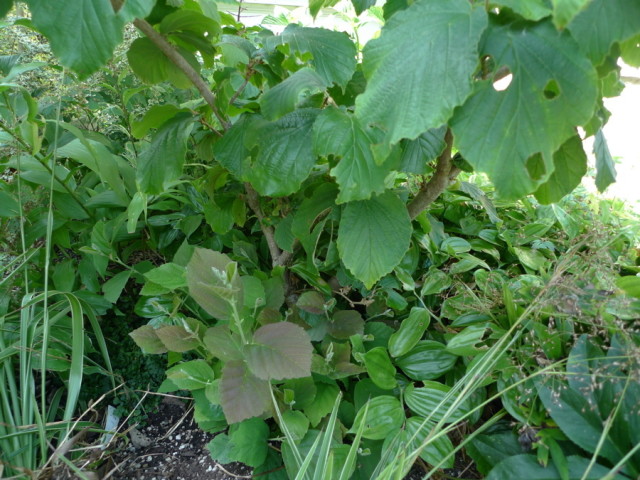Suckers!

Suckers can be hard to tell apart from regular foliage but there are a few tell-tale signs: for one, they always grow below the graft point, which is often a subtle swelling at the base of a trunk. Suckers can also be slightly different in color (as in this photo) or have slightly coarser, larger or hairier foliage.
Have you ever had a plant that seemed to morph from the fabulous treasure you bought into a strange and possibly unattractive monster with coarse leaves, dull flowers or oddly flavorless and pitifully small fruit? It’s possible that your plant’s rootstock took over.
There are many grafted plants on the market: most witch hazels, roses, some magnolias, grapes, fruit trees, wisteria vines, and many more ornamental and fruiting plants are commonly grafted onto disease-resistant, vigorous rootstocks.
The practice of grafting is used by growers to bring slow-growing plants to flowering size more quickly. Witch hazels and magnolias, for example, can take 5-7 years to flower when grown from cuttings, but slap ‘em onto a vigorous rootstock and they can flower at six inches high. Grafted roses can reach flowering size twice as fast as non-grafted roses. Sometimes it’s a disease or size issue: fruit trees are grafted onto dwarfing rootstocks to keep their size in check, and wine grapes are grafted onto disease-resistant rootstock.
Grafting simply means splicing the plant you want (a large yellow-flowered, fragrant witch hazel, for example, or a particularly luscious rose) onto a fast-growing, vigorous rootstock of the same kind of plant. The desirable part is called the "scion"; the rootstock is called, well, the rootstock.
If that ultra-vigorous rootstock takes over and engulfs the scion (topmost, desirable) part of the plant, you can lose the scion completely. How does this happen?
Over-zealous pruning: if the top is cut back too hard, all the way back to the graft, then there’s nothing left but rootstock to sprout and grow.
Neglect: if you don’t regularly check the base of the plant to nip off suckers, then you can end up with long shoots growing out from below the graft. These shoots are usually really vigorous and can quickly smother the scion.
Excessively deep planting: if a grafted plant is too deeply planted, the stem below the graft point can root and send up suckers. Which do you-know-what.
The fact is, grafted plants require a little extra attention. Check the rootstock on grafted plants at least twice a year to see whether there are shoots emerging from the base of the plant, below the graft. The graft point is usually indicated by a little swelling at the base of the trunk, although some ornamental cherry trees or tree roses will be grafted at the top of the trunk, where the branches emerge.
{% display:image for:post image:1 align:right height:350 %}
If you see suckers growing below the graft, and they are just a couple of inches long and flexible, the best solution is to just rub them off with your fingers. If they have already turned kind of woody and won’t just rub off, take sharp clippers and cut them off as close to the trunk as possible. Do this whenever you see them… but check at least twice a year, in spring and fall.
Suckering is usually most intense during a tree or vine’s first few years. Once the tree is established, this suckering diminishes. Sometimes you’ll notice it happen when the roots have been disturbed – for example, by transplanting or a lot of digging and root disruption. But generally, once the plant is established and left alone, you don’t have to worry about it too much.
